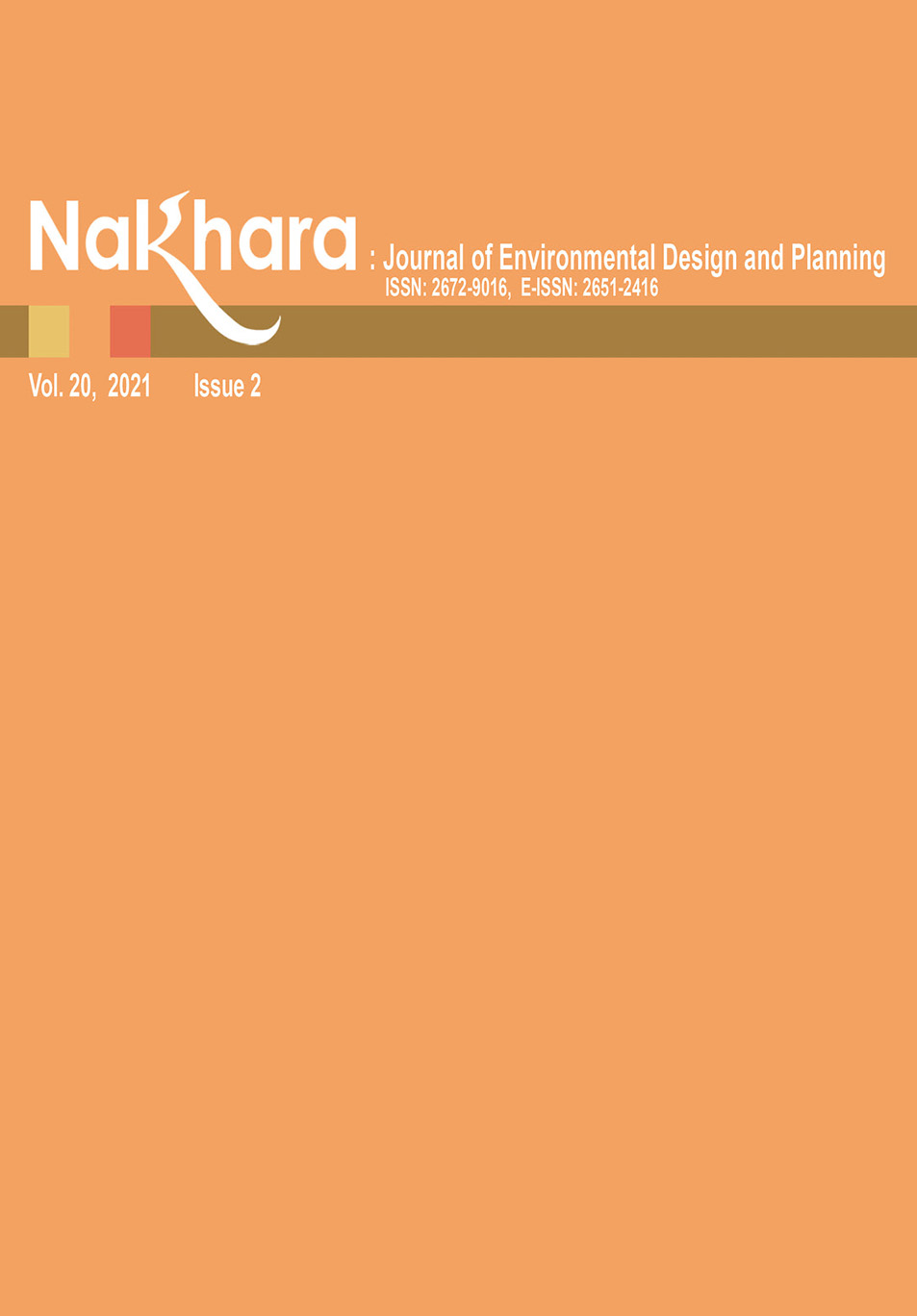Globality in Teaching Art and Architectural History: A Case Study of the Glossary Assignment
Main Article Content
Abstract
In consideration of the research problem associated with the need for globality and inclusive vision in art and architecture history pedagogy, this research proposes an alternative research framework that entails the globality and inclusion of non-Western content in studying and teaching art and architecture history, as well as the use of interpretive-historical research methodology in conducting cross-cultural and comparative studies for a glossary assignment. This research provides a glossary assignment in which students conduct cross-cultural and comparative investigations of Western and non-Western art and architecture. The study approaches, tactics, and themes employed by students to do cross-cultural comparisons are systematically examined. Common glossary terms from conventional Western art and architecture history, namely, composite image, ziggurat, contrapposto, and still life, are critically used to demonstrate that they are universal and also existent in Southeast Asian art and architecture. Inductive rather than a priori analytical framework reveals new themes derived from cross-cultural comparisons. By juxtaposing original redrawn images of art and architecture from Western traditions and non-Western contexts, this research creates a significant visual impact on the usage of illustrations as tactics that transcend conventional maps and timelines. Application of the alternative study framework reveals the universality of the human desire to create art and architecture that transcends chronology and cultural boundaries.
Article Details

This work is licensed under a Creative Commons Attribution-NonCommercial-NoDerivatives 4.0 International License.
References
Ardnarong, P. (2016). Phonngan thatsanasin samai sukhothai [Visual works of Sukhothai period]. Retrieved February 2, 2021, from https://medium.com/@pasubox
Britannica. (2020). Ziggurat. Retrieved February 2, 2021, from https://www.britannica.com/technology/ziggurat
Candi Sukuh. (2020). Retrieved February 2, 2021, from https://www.lonelyplanet.com/indonesia/gunung-lawu/attractions/candi-sukuh/a/poi-sig/1189560/1322079
Chattopadhyay, S. (2015). The globality of architectural history. Journal of the Society of Architectural Historians, 74(4), 411-415.
Cline, L. K. (2017). Still life with peaches. Retrieved February 2, 2021, from https://www.khanacademy.org/humanities/ancient-art-civilizations/roman/wall-painting/a/still-life-with-peaches
Contrapposto. (2020). Retrieved February 2, 2021, from https://en.wikipedia.org/w/index.php?title=Contrapposto&oldid=996477905
Cranz, G. (2016). Ethnography for designers. Routledge.
Davies, P. J. E., Janson, H. W., Denny, W. B., Hofrichter, F. F., Jacobs, J., Roberts, A. M., & Simon, D. L. (2012). Janson's history of art: The ancient world (8th ed.). Prentice Hall.
Detroit Institute of Arts. (n.d.). Draped female figure, between 2nd and 1st century BCE. Retrieved February 2, 2021, from https://www.dia.org/art/collection/object/draped-female-figure-46496
Dlium. (2019). Plaosan Lor Temple. https://www.youtube.com/watch?v=QqEMZ9W3rBQ
Groat, L. N. (2002). Systems of Inquiry and Standards of Research Quality. In L. N. Groat & D. Wang (Eds.), Architectural research methods (pp. 21-43). John Wiley & Sons.
Groat, L. N., & Wang, D. (2002). Architectural research methods. John Wiley & Sons.
Kartapranata, G. (2015). Plaosan Bodhisattva. Retrieved February 2, 2021, from https://commons.wikimedia.org/wiki/File:Plaosan_Bodhisattva_01.jpg
Katz, E. L., Lankford, E. L., & Plank, J. D. (1995). Themes and foundations of art. National Textbook.
Lazzari, M. R., & Schlesier, D. (2005). Exploring art: A global, thematic approach (2nd ed.). Wadsworth.
Lindner, M. (2006). The woman from Frosinone: Honorific portrait statues of Roman imperial women. Memoirs of the American Academy in Rome, 51/52(2006-2007), 43-85. http://www.jstor.org.chula.idm.oclc.org/stable/25609490
Maass, J. (1969). Where architectural historians fear to tread. Journal of the Society of Architectural Historians, 28(1), 3-8. https://doi.org/10.2307/988523
Oxford University Press. (2021a). Composite. Retrieved February 2, 2021, from https://www.oxfordlearnersdictionaries.com/definition/english/composite
Oxford University Press. (2021b). Image. Retrieved February 2, 2021, from https://www.oxfordlearnersdictionaries.com/definition/english/image
Oxford University Press. (2021c). Theme. Retrieved February 2, 2021, from https://www.oxfordlearnersdictionaries.com/definition/english/theme_1
Phokhaw, T., & Chunghom, S. (2021). Allegory and contrapposto [Unpublished manuscript]. Chulalongkorn University.
Plaosan. (2020). Retrieved February 2, 2021, from https://en.wikipedia.org/wiki/Plaosan
Prasitporn, P., & Ngammongkolwong, P. (2021). Rotolus and still life [Unpublished manuscript]. Chulalongkorn University.
Sacred sites in Southeast Asia, Candi Sukuh. (n.d.). Retrieved February 2, 2021, from https://asia.si.edu/collections-area/southeast-asian/sacred-sites-in-southeast-asia-candi-sukuh/
Sarathy, J. (n.d.). Art of ancient Egypt. Retrieved February 2, 2021, from https://arthistoryteachingresources.org/lessons/art-of-ancient-egypt
Sarikkabut, P. (n.d.). Khao Plara [Plara Mountain]. Retrieved February 2, 2021, from http://www.era.su.ac.th/Rockpainting/central/Khao-plara/index.html
Seeumpornroj, P. (2021). Assignment 01: Glossary of art and architecture of the ancient world from Prehistoric to Roman Era [Unpublished assignment handout]. Department of Architecture, Chulalongkorn Univeristy.
Smarthistory. (2020). Contrapposto explained. https://www.youtube.com/watch?v=5vK7Z2Odnc0
Soonpongsri, K. (2552). Prawattisat sinlapa tawantok nueng [Western art history 1]. Chulalongkorn University Press.
Teerajaruwan, A. (2549). Rupkhian duekdamban "Suwannaphum" samphan pi ma laeo tonbaep ngan changkhian patchuban [Ancient painting "Suwannaphum" 3,000 years ago, the prototype of the current painter work]. Matichon Press.
Terry, J. (n.d.). Composite pose. Retrieved February 2, 2021, from https://blog.stephens.edu/arh101glossary/
Terwiel, B. J. (2013). The hidden jataka of Wat Si Chum: A new perspective on 14th and early 15th century Thai buddhism. Journal of the Siam Society, 101, 1-17. https://thesiamsociety.org/wp-content/uploads/2013/04/JSS_101_0b_Terwiel_TheHiddenJatakaOfWatSiChumANewPerspective.pdf
The Fine Arts Department of Thailand. (n.d.). Khao Phu Plara (Khao Plara) [Plara Mountain]. Retrieved February 2, 2021, from https://www.finearts.go.th/main/view/19367
The National Library of the Republic of Indonesia. (2004). Sukuh Temple. Retrieved February 2, 2021, from https://candi.perpusnas.go.id/temples_en/deskripsi-central_java-sukuh_temple_26
Wang, D. (2002). Interpretive-historical research. In Architectural research methods (pp. 135-172). John Wiley & Sons.
Wannasirikul, M., & Phayakharasmit, L. (2021). Composite image and ziggurat [Unpublished manuscript]. Chulalongkorn University.
Zeisel, J. (2006). Research methodology: Approaches, designs, and settings. In Inquiry by design: Environment / behavior / neuroscience in architecture, interiors, landscape, and planning (pp. 91-118). Norton.

